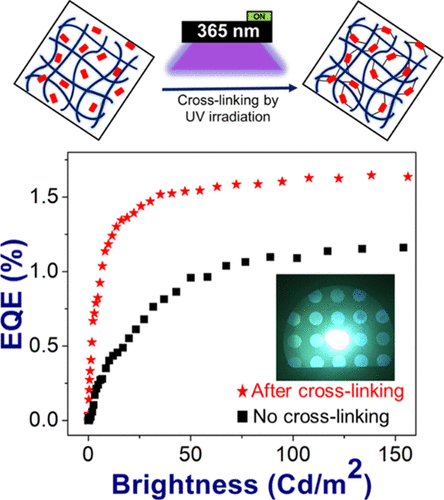当前位置:
X-MOL 学术
›
ACS Appl. Electron. Mater.
›
论文详情
Our official English website, www.x-mol.net, welcomes your feedback! (Note: you will need to create a separate account there.)
Effect of Bis-diazirine-Mediated Photo-Crosslinking on Polyvinylcarbazole and Solution-Processed Polymer LEDs
ACS Applied Electronic Materials ( IF 4.7 ) Pub Date : 2021-08-06 , DOI: 10.1021/acsaelm.1c00354 Kaustav Dey 1 , S. Roy Chowdhury 1 , Erik Dykstra 2 , H. Peter Lu 1 , Ruth Shinar 3 , Joseph Shinar 2 , Pavel Anzenbacher 1
ACS Applied Electronic Materials ( IF 4.7 ) Pub Date : 2021-08-06 , DOI: 10.1021/acsaelm.1c00354 Kaustav Dey 1 , S. Roy Chowdhury 1 , Erik Dykstra 2 , H. Peter Lu 1 , Ruth Shinar 3 , Joseph Shinar 2 , Pavel Anzenbacher 1
Affiliation

|
The problems with fabrication of solution-processed organic light-emitting diodes (OLEDs) stem largely from the defects associated with sequential deposition of the layers, solvent-induced surface erosion, and layer mixing. Herein, we demonstrate that a photopolymerizable bis-diazirine molecule can easily convert soluble polymers into cross-linked insoluble materials, alleviating the problems associated with inter-layer mixing. Upon 5–20 min irradiation with long wavelength/low power UV (1.8 mW/cm2) bis-diazirines results in the formation of carbenes that can react via carbon–hydrogen bond insertion with polymers or small molecules yielding cross-linked networks. The effectiveness of the bisdiazirine-mediated photo-cross-linking has been studied by investigating the surface morphology of the hole-transporting material polyvinylcarbazole (PVK), which exhibited 45% decrease in surface roughness after 15 min of the UV irradiation. The effect of this cross-linking procedure on device performance was studied in OLEDs with the configuration of indium tin oxide/PEDOT:PSS/PVK:(0–10%) cross-linker/PFO:2% F8BT/TPBI/CsF/Al. After the photolysis of the diazirines, the experimental devices exhibited a 42% enhancement in the maximum external quantum efficiency (EQEmax), from 1.2 to 1.7%, and a maximum luminous efficiency improvement from 3.9 to 5.4 cd/A. Overall, this observation suggests that 3-trifluoromethyl(aryl)diazirine-based cross-linking processes is a promising method for fabrication of polymer LEDs.
中文翻译:

双二氮嗪介导的光交联对聚乙烯咔唑和溶液加工聚合物 LED 的影响
溶液处理有机发光二极管 (OLED) 的制造问题主要源于与层的顺序沉积、溶剂引起的表面侵蚀和层混合相关的缺陷。在此,我们证明可光聚合的双二氮丙啶分子可以轻松地将可溶性聚合物转化为交联的不溶性材料,从而缓解与层间混合相关的问题。用长波长/低功率紫外线 (1.8 mW/cm 2) 双二氮杂导致卡宾的形成,卡宾可以通过碳氢键插入与聚合物或小分子反应,产生交联网络。通过研究空穴传输材料聚乙烯咔唑 (PVK) 的表面形态,研究了双二氮丙啶介导的光交联的有效性,在紫外线照射 15 分钟后,其表面粗糙度降低了 45%。在具有氧化铟锡/PEDOT:PSS/PVK:(0–10%) 交联剂/PFO:2% F8BT/TPBI/CsF/Al 配置的 OLED 中研究了这种交联程序对器件性能的影响. 在二氮嗪光解后,实验装置的最大外量子效率(EQE max),从 1.2% 到 1.7%,最大发光效率提高从 3.9 到 5.4 cd/A。总体而言,这一观察结果表明基于 3-三氟甲基(芳基)二氮丙啶的交联工艺是一种很有前景的聚合物 LED 制造方法。
更新日期:2021-08-24
中文翻译:

双二氮嗪介导的光交联对聚乙烯咔唑和溶液加工聚合物 LED 的影响
溶液处理有机发光二极管 (OLED) 的制造问题主要源于与层的顺序沉积、溶剂引起的表面侵蚀和层混合相关的缺陷。在此,我们证明可光聚合的双二氮丙啶分子可以轻松地将可溶性聚合物转化为交联的不溶性材料,从而缓解与层间混合相关的问题。用长波长/低功率紫外线 (1.8 mW/cm 2) 双二氮杂导致卡宾的形成,卡宾可以通过碳氢键插入与聚合物或小分子反应,产生交联网络。通过研究空穴传输材料聚乙烯咔唑 (PVK) 的表面形态,研究了双二氮丙啶介导的光交联的有效性,在紫外线照射 15 分钟后,其表面粗糙度降低了 45%。在具有氧化铟锡/PEDOT:PSS/PVK:(0–10%) 交联剂/PFO:2% F8BT/TPBI/CsF/Al 配置的 OLED 中研究了这种交联程序对器件性能的影响. 在二氮嗪光解后,实验装置的最大外量子效率(EQE max),从 1.2% 到 1.7%,最大发光效率提高从 3.9 到 5.4 cd/A。总体而言,这一观察结果表明基于 3-三氟甲基(芳基)二氮丙啶的交联工艺是一种很有前景的聚合物 LED 制造方法。


























 京公网安备 11010802027423号
京公网安备 11010802027423号